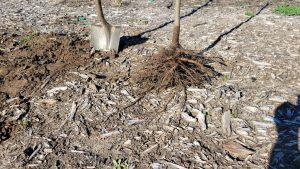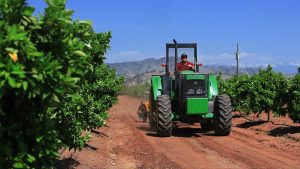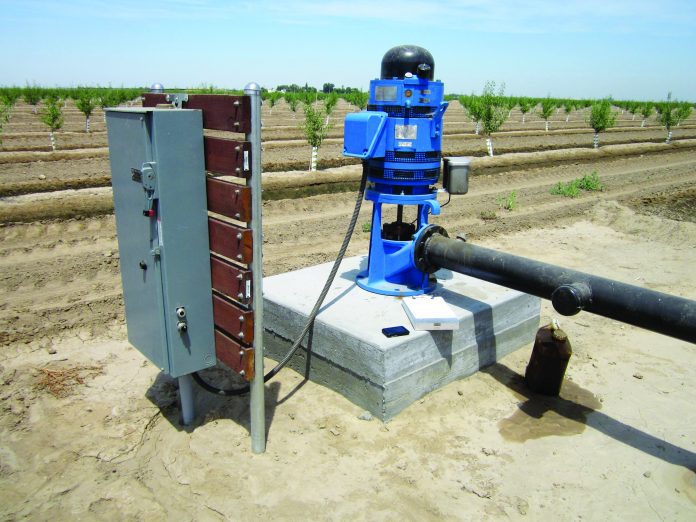Unlike healthy profit margins and irrigation water, grower incentives and support to tackle farming challenges are not in short supply. The Almond Board’s Grower Support Zone at the annual conference included many federal, state and local programs that offer financial assistance for adoption of specific farming practices.
Incentive programs included improvement in irrigation efficiency, reduction of emissions from farm equipment, dust reduction, groundwater recharge and pollinator habitat protection. Many of these incentive programs are offshoots of research projects with funding from ABC and have proven agronomic benefits.
1) Alternatives to Burning Program
The San Joaquin Valley Air Pollution Control District provides incentives to agriculture operations located inside the district boundaries to chip or shred orchard or vineyard waste and use in soil incorporation or land application.
Projects include whole orchard recycling and chipping with land application of mulch or other on-site application. The maximum incentive per acre is $600 for soil incorporation with a maximum of $60,000 per applicant per year. Chipping without soil incorporation pays $300 per acre with a $30,000 maximum. Chips may not be used for any other purpose. None of the orchard or vineyard material can be burned, composted or removed to a biomass facility.
In addition to the application forms, the district requires an itemized quote from the service provider detailing the work planned and a confirmation of the crop and acreage.
There is a pre-inspection of the orchard or vineyard site.
After an application is approved, a district voucher will be issued. The grower has 180 days from the date on the voucher to complete the project. There will be a post-inspection site visit from district staff; once the inspection is completed and meets requirements, payment will be issued.

2) Irrigation System Grants
The State Water Efficiency and Enhancement Program (SWEEP) awards grants for growers to invest in irrigation system enhancements that reduce water and energy use and increase water and energy use efficiency. This program has awarded more than $123 million as of 2021 for 1,130 projects. Recipients of the grants have contributed more than $70 million in matching funds.
Eligible projects include soil moisture monitoring, implementing pressurized irrigation systems, retrofitting pumps, use of variable frequency drives and installation of solar energy.
3) Healthy Soils Incentive Program
The aim of CDFA’s Healthy Soils Incentive Program is to promote adoption by growers of conservation management practices. Those practices include carbon sequestration in the soil, reduction of greenhouse gas and improvement of soil health.
Greenhouse gas reductions are estimated using quantification methodology and tools developed by California Air Resources Board. Soil health improvement will be assessed by measuring soil organic matter content.
Orchard practices eligible for financial assistance include compost applications with material produced on-farm or purchased from a certified facility, cover cropping, filter strips, hedgerow planting, nutrient management with reduction in fertilizer use, whole orchard recycling and residue and tillage management.

4) NOW Mating Disruption Neighborhood Management
This support program aims to increase the use of navel orangeworm mating disruption among almond, walnut and pistachio growers, particularly in smaller size orchards. It encourages the creation of larger NOW management blocks across host crops that plan for areawide deployment of mating disruption (MD).
California Department of Pesticide Regulation and Almond Board of California are providing grant funding with support from Land IQ, Blue Diamond and UCCE. This produced an online tool where growers and PCAs can express interest in MD neighborhood blocks. In areas with significant interest, project partners will organize meetings and facilitate connections among neighboring growers along with publicizing the availability of grants from Natural Resources Conservation Service that can fund IPM practices including MD.
According to ABC, research has shown a 35% to 53% reduction in NOW damage when MD is used in smaller blocks, while the rate of damage reduction is higher in larger blocks. Due to the limited benefits, adoption of MD has lagged among small growers.
The Neighborhood Management project has developed an online tool at agneighbors.com to help drive areawide effective and voluntary MD adoption. Where large contiguous blocks of growers using the tool show interest in 2023, a field site will be selected for focused outreach and adoption.
The online tool development is being led by Land IQ. PCAs and growers are invited to identify parcels they manage on a map, whether they use MD or not, and through participation express interest in forming an NOW Neighborhood Management Block. Where interest among growers reaches 40 contiguous acres or more, participants will be notified that there is a match with their neighbors. Growers also qualify for NRCS incentive funds to deploy IPM practices including MD. For more information, contact Jesse Roseman at jroseman@almondboard.com.
5) Ag Equipment Funding
Grants from the San Joaquin Valley Air Pollution Control District include tractor replacement, UTV replacement and agricultural pumps.
The ag tractor program offers up to 80% of the eligible cost of new equipment. Conditions include scrap of Tier 0, Tier 1 or Tier 2 tractors. Those who farm less than 100 acres are eligible for the small farmer pre-owned equipment. Growers can replace Tier 0 or 1 equipment with certified pre-owned Tier 3 or cleaner equipment.
Growers who want to replace old diesel or gasoline powered UTVs with new electric models can receive up to 75% of the total eligible equipment cost.
Ag pump replacement program offers up to 85% of eligible cost. Grants are for replacing a Tier 3 diesel with a Tier 4f diesel or replacing a Tier 3 with electric with line extension.
Complete information at grants@valleyair.org or www.valleyair.org/grants.


Cecilia Parsons | Associate Editor
Cecilia Parsons has lived in the Central Valley community of Ducor since 1976, covering agriculture for numerous agricultural publications over the years. She has found and nurtured many wonderful and helpful contacts in the ag community, including the UCCE advisors, allowing for news coverage that focuses on the basics of food production.
She is always on the search for new ag topics that can help growers and processors in the San Joaquin Valley improve their bottom line.
In her free time, Cecilia rides her horse, Holly in ranch versatility shows and raises registered Shetland sheep which she exhibits at county and state fairs during the summer.
















